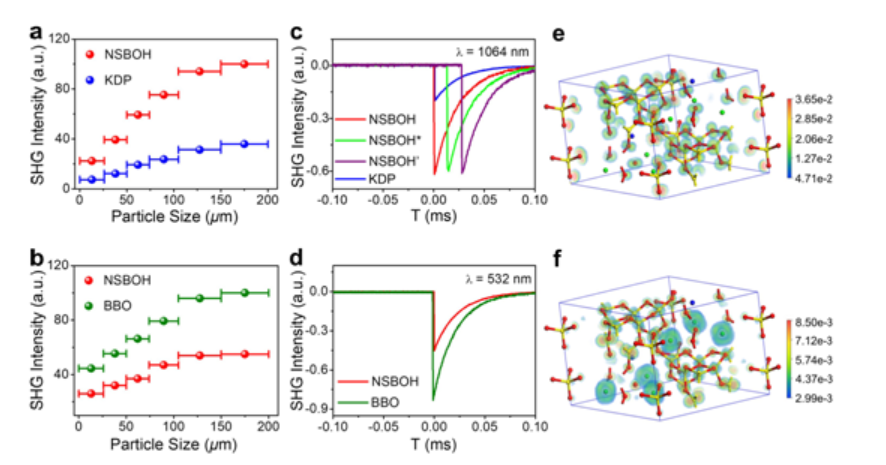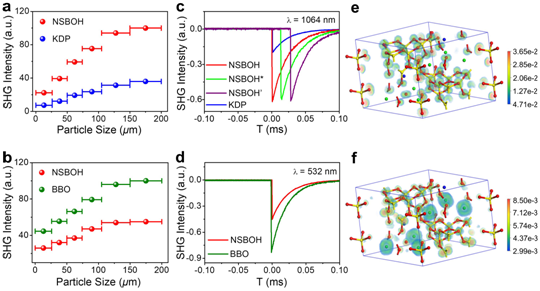Deep-ultraviolet (λ<200 nm) second-order nonlinear optical crystal is a key component for the all-solid-state laser to output deep ultraviolet laser, playing an irreplaceable role in optical communication, medical diagnosis & treatment, deep space exploration, and military technology.Currently, only the KBe2BO3F2(KBBF) crystal invented by Chinese scientists can directly output deep ultraviolet laser at a doubled frequency in practical application. However, it is difficult to obtain large-sized KBBF crystals due to their lamellar growth feature. In addition, raw materials for synthesizing KBBF crystals require highly toxic beryllium oxide, greatly restricting the commercialization and application of KBBF crystals. Therefore, it remains a challenging problem to explore the design and synthesis of deep ultraviolet oxide crystals with high deep ultraviolet transparency, large SHG response, and sufficient birefringence.

The research team of Zhang Chi, the Academician of the European Academy of Sciences and Dean of the School of Chemical Science and Engineering, Tongji University, proposed a covalent bond modulation strategy by studying the classic borate, created a deep ultraviolet beryllium-free second-order nonlinear optical crystal NaSr3(OH)(B9O16)[B(OH)4] (NSBOH) with a three-dimensional covalent framework, and discussed and illustrated how this deep ultraviolet crystalline material realizes a large SHG response. The achievement "Strong SHG Responses in a Beryllium-Free Deep-UV-Transparent Hydroxyborate via Covalent Bond Modification" has been published as a Research Article inAngewandte Chemie International Edition (2021, 60(52), 27151-27157, the last issue of this year), the most important academic journal in the global chemistry field and was selected as aHot Paperby the Angewandte Chemie Editorial Board for its important innovation and high recognition by peer experts.

In this study, the research team, based on the chemical synthesis method of borate solution, took the deep ultraviolet second-order nonlinear optical crystal NaSr3Be3O9F4(NSBBOF) as the structural model and adopted the covalent bond modulation strategy for the iso-site replacement of tetrahedral primitives [BO4] and [BeO3F] in the material, to finally obtain the beryllium-free borate crystalline materials. The high concentration of borate solution is conducive to the agglomeration of [BO3]/[BO4] groups into B-O clusters with a higher nucleus, further forming a covalent framework with a three-dimensional structure. This structure can give the material a large optical band gap, achieving a higher UV transparency. Based on this covalent bond modulation strategy, the research team successfully designed and synthesized a beryllium-free hydroxyborate composed of [B9O19] clusters. According to experimental results, the NSBOH crystal shows good physicochemical stability, with a UV absorption cutoff smaller than 190 nm, consistent with the theoretical value of 178 nm. NSBOH has a strong SHG response (3.3 × KH2PO4 @ 1064 nm, 0.55 × β-BaB2O4 @ 532 nm) in both visible and ultraviolet bands, which is the maximum value of deep ultraviolet borate crystalline materials, demonstrating excellent performance as a deep ultraviolet second-order nonlinear optical crystal material. This research is of great significance for the exploration of deep ultraviolet second-order nonlinear optical crystals with excellent design performance in hydroxyborate systems.

Compared with the above-mentioned π-conjugated deep ultraviolet second-order nonlinear optical crystals, the non-π-conjugated deep ultraviolet second-order nonlinear optical crystals exhibit a shorter UV absorption cutoff. However, most reported non-π-conjugated deep UV second-order nonlinear optical crystals have a weak second-order nonlinear optical effect. Confronting this conundrum, the research team led by Academician Zhang Chi proposed a compound cationic salt strategy with non-π-conjugated sulfate as the research object and built a deep ultraviolet second-order nonlinear optical crystalline material of rare earth-based sulfate with a strong SHG response. The achievement "A Lanthanum Ammonium Sulfate Double Salt with a Strong SHG Response and Wide Deep-UV Transparency" was published online inAngewandte Chemie International Edition (2021, DOI:10.1002/anie.202115855)as a newsletter and was selected as aHot Paperby the Angewandte Chemie Editorial Board. This is the seventh achievement among its important research results that Zhang Chi's research team has published in top international chemical journals this year.

In this study, the research team worked out a design idea for synergistic compensation of the SHG response of sulfate crystalline materials by organic ammonium and rare-earth metal cations, allowing synchronous gain optimization in both SHG response and UV transparency for the material. Organic ammonium and rare-earth metal cations eliminate the d-d or f-f electron transitions and can extend the ultraviolet transmission window of the material. Rare-earth metal cations La3+can form distorted metal central polyhedrons, which can enhance the SHG response of materials when the structural primitives with large hyperpolarization are aligned. Compared with alkali-metal/alkaline-earth metal cations, the [NH4]+ cation and [SO4] group can form hydrogen bonds with a strong intermolecular force. Moreover, high-valent rare earth ions have a shorter La−O bond length, allowing the two to be connected in such a way as to enhance the bonding force between structural primitives, which facilitates the tight accumulation of structural primitives and gives materials a stronger SHG response. Based on this design strategy of the compound cationic salt, a deep ultraviolet second-order nonlinear optical crystal La(NH4)(SO4)2with outstanding performance was successfully created.

Via simulation calculations with single-crystal structure analysis and with reference to the first principle theory, the research team further discussed and clarified the internal physical mechanism that La(NH4)(SO4)2can achieve the balance between SHG response and UV transparency, and revealed that the main reasons for materials to receive a strong SHG response and wide UV transparency lie in the synergistic effect of organic ammonium and rare-earth cation La3+, as well as the consistent arrangement of [SO4] and [LaO8] groups under their induction. The rare earth-based sulfate La(NH4)(SO4)2exhibits a short UV absorption cutoff (experimental value: ˂ 190 nm; theoretical value: 167 nm); La(NH4)(SO4)2 also demonstrates a strong SHG response (2.4 × KDP @ 1064 nm), the maximum in the deep ultraviolet sulfate system, so far reported. This study provides a new design idea for exploring deep ultraviolet second-order nonlinear optical crystalline materials.
The research team led by Academician Zhang Chi has made a series of major progress in the research of oxide frequency-doubling crystalline materials in 2021. They proposed an effective strategy for synergistically improving the birefringence and SHG response of short-wave ultraviolet optical crystals, with the achievement "Giant Optical Anisotropy in the UV‐Transparent 2D Nonlinear Optical Material Sc(IO3)2(NO3)" published inAngewandte Chemie International Edition (2021, 60(7), 3464-3468, ESI TOP 1% most cited papers); made a breakthrough in synchronous gain optimization of optical SHG response and birefringence for sulfate crystals, with the achievement "Large Second-Harmonic Response and Giant Birefringence of CeF2(SO4) Induced by Highly Polarizable Polyhedra" published inJournal of the American Chemical Society (2021, 143(11), 4138-4142, cover article, ESI TOP 1% most cited papers); developed a new method for building a second-order nonlinear optical crystal of UV solar-blind-region phosphate, with the achievement "UV Solar-Blind-Region Phase-Matchable Optical Nonlinearity and Anisotropy in a π-Conjugated Cation-Containing Phosphate" published inAngewandte Chemie International Edition (2021, 60(27), 14806-14810, Cover Article, Hot Paper); presented an effective strategy for constructing high-performance mid-infrared oxide crystals with the partial fluorination method, with the achievement "Giant Second-Harmonic Generation Response and Large Band Gap in the Partially Fluorinated Mid-Infrared Oxide RbTeMo2O8F" published inJournal of the American Chemical Society (2021, 143(32), 12455-12459); realized the synchronous gain of infrared transparency and SHG response for vanadate nonlinear optical crystals, with the achievement "A Congruent-Melting Mid-Infrared Nonlinear Optical Vanadate Exhibiting Strong Second-Harmonic Generation" published inAngewandte Chemie International Edition (2021, 60(41), 22447-22453, Hot Paper).
The above research work has gained wide support from the National Natural Science Foundation of China, the Program for Innovative Research Team in University by the Ministry of Education, the Program for Innovative Research Team in Key Fields by the Ministry of Science and Technology, and Key Projects of Science and Technology Innovation Plan of Shanghai Municipal Education Commission. For the paper series, Academician Zhang Chi is the corresponding author, while Dr. Wu Chao, together with doctoral students Hu Yilei and Wu Tianhui, are the first/co-first authors. Professor Huang Zhipeng has participated in the research work of the paper series.